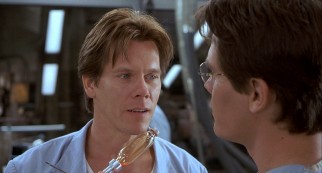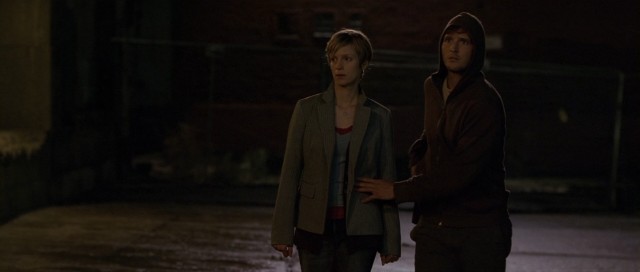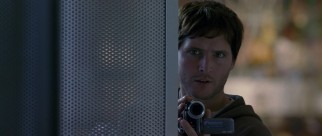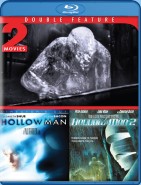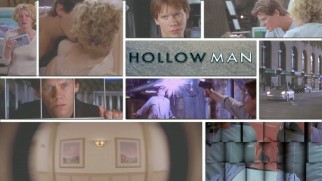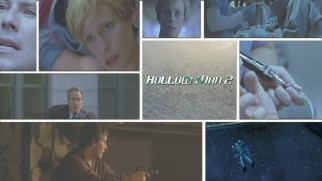Hollow Man & Hollow Man II: Double Feature Blu-ray Review
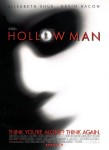 |
Hollow Man
Theatrical Release: August 4, 2000 (Director's Cut Video Release: October 16, 2007) / Running Time: 119 Minutes (Director's Cut) / Rating: Unrated (Director's Cut) Director: Paul Verhoeven / Writers: Andrew W. Marlowe (story & screenplay); Gary Scott Thompson (story) Cast: Elisabeth Shue (Linda McKay), Kevin Bacon (Sebastian Caine), Josh Brolin (Matthew Kensington), Kim Dickens (Sarah Kennedy), Greg Grunberg (Carter Abbey), Joey Slotnick (Frank Chase), Mary Randle (Janice Walton), William Devane (Dr. Howard Kramer), Rhona Mitra (Sebastian's Neighbor), Pablo Espinosa (Ed the Warehouse Guard), Margot Rose (Mrs. Martha Kramer), Jimmie F. Skaggs (Wino), Jeffrey George Scaperotta (Boy in Car), Sarah Bowles (Girl in Car) |
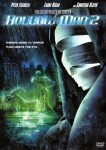 |
Hollow Man II
Video Premiere: May 23, 2006 / Running Time: 91 Minutes / Rating: R Director: Claudio Faeh / Writers: Joel Soisson (screenplay), Gary Scott Thompson (story & characters), Andrew W. Marlowe (characters) Cast: Christian Slater (Michael Griffin), Peter Facinelli (Detective Frank Turner), Laura Regan (Dr. Maggie Dalton), David McIlwraith (Dr. William Reisner), William MacDonald (Colonel Gavin Bishop), Sarah Deakins (Detective Lisa Martinez), Jessica Harmon (Heather Dalton), Sonya Salomaa (Trophy Wife), Terri Anne Welyki (Pearl Girl), John Shaw (Dr. Devin Villiers), Colin Lawrence (Captain Rollins), Zara Taylor (Ashley), Nolan Funk (Josh), Bruce Dawson (Captain Tom Harrison), Darcy Laurie (Timothy Laurents), Mike Dopud (Officer Chesley), Woody Jeffreys (Agent Moore) |
Buy Hollow Man & Hollow Man 2 Double Feature Blu-ray from Amazon.com
Invisibility is a concept that lends itself to movie magic. Put clothing on a wire and shoot from an angle that hides it or nowadays do something more sophisticated and erase the seams digitally and voilà. The illusion was achieved on film as early as 1933's The Invisible Man, adapted from H.G. Wells' 1897 novel. Since then, it has been put to use every once in a while The year 2000 gave us one of the most extensive contemplations of the state in Hollow Man. Conceived and co-written by Andrew W. Marlowe, the Air Force One and End of Days scribe better known in recent years for creating and show-running ABC's mystery series "Castle", Hollow Man is directed by Paul Verhoeven, no stranger to outlandish science fiction and cinema, having made movies like RoboCop, Total Recall, Starship Troopers, and Showgirls.
The film is set primarily in a medical research lab, where classified tests are being conducted on gorillas and other animals. The leader of the operation, the unethical, egomaniacal, Twinkie-fueled genius Sebastian Caine (Kevin Bacon), reports to his superiors at the Pentagon that he and his colleagues are still trying to work out how to safely bring animals back to visibility. That isn't true, but it keeps the scientists employed and their work in their own hands.
Sebastian, meanwhile, is prepared to jump ahead to Phase 3: human testing. His colleagues, including his ex-girlfriend Linda (Elisabeth Shue) and her, unbeknownst to Sebastian, new boyfriend Matthew (Josh Brolin), voice concerns. But Sebastian fearlessly volunteers to be the guinea pig and he is injected with the invisibility serum. As you can probably guess, the doctors can't restore him to his natural state, leaving him invisible indefinitely. The initial concerns are mild; transparent eyelids make him sensitive to the light. But this being a Paul Verhoeven movie, it isn't long before Sebastian's baser instincts allow him to enjoy the perks of undetectability. He immediately becomes a stalker/raper and shortly thereafter a killer.
Though fitted with a latex mask and gloves to announce his whereabouts to colleagues, who also make use of infrared goggles, Sebastian hatches some workarounds as he sneaks out on the town, spies on his co-workers, and, in an Alien-esque scenario, traps them in their laboratory to off them one at a time.
This is one of cinema's dumber applications of invisibility. As with Verhoeven's other films, one wonders if there isn't an element of satire or social commentary behind the surface stupidity. Here, that seems pretty unlikely.
While it feels like a modern-day B-movie, Hollow Man is not a complete loss. The visual effects, nominated for the Academy Award won by Gladiator, are quite impressive. Some of the CGI used to depict skeletons in the transitional state is dated but passable. Far more impressive is the use of green screen to present the convincing image of a man invisible under a latex mask. You see right through those eye and mouth openings to the back of the mask without a trace of artificiality. Having Sebastian assume the properties of other elements, like water and steam, is also done skillfully.
The climactic action sequences are at least decently staged by Verhoeven, even if they are full of implausibilities and logic lapses. If you've stayed with the movie long enough to get there, chances are your interest will be sustained. Unknown invisibility is a frightening notion, which the movie sometimes manages to convey. One wishes we weren't immediately taken to a dark, rapey place, because such a revolting turn seems to waste genuine horror potential. Perhaps the first-person photography would grow old, but it seems the terrifying idea of an unseen intruder is somewhat squandered here.
Released on the first week of August 2000, Hollow Man bested Coyote Ugly, Clint Eastwood's Space Cowboys, and second weekend holdover The Nutty Professor II: The Klumps to open #1 at the box office. Interestingly, this appears to be the only time in history that Elisabeth Shue would command higher billing than Kevin Bacon, who features more prominently albeit often in silent, invisible state. Shue was four years removed from her Leaving Las Vegas Best Actress Oscar nomination and three from leading lady duties in the well-performing Val Kilmer vehicle The Saint. She hasn't enjoyed as prominent exposure since, despite some potentially career-reviving turns in Hamlet 2 and Piranha. (I must say it seems preposterous that Hollow Man claims her top "Known For" spot on IMDb and Adventures in Babysitting doesn't get any of the four.) Bacon has stuck around more, although noteworthy film credits this century (Mystic River, Frost/Nixon, X-Men: First Class) have been fairly staggered. Both actors can now be found on television: Shue on "CSI" and Bacon on Fox's recently-renewed "The Following."
Hollow Man is not the kind of movie that screams "sequel", but six years after it was released, it got one in the direct-to-video Hollow Man II (Roman numeral on screen, Arabic one on cover). In the middle of last decade, during the height of DVD's success, many studios began making these inexpensive follow-ups to well-known, moderately popular films. Sony sequelized the likes of Cruel Intentions, Wild Things, I Know What You Did Last Summer, and Road House. As you would expect, none of the original cast ever returned (Verhoeven took an executive producer credit here). Nor did the characters, for that matter, rendering Hollow Man II somewhat more of a remake than a sequel.
The connection to the first film is slight and more thematic than narrative. Picking up five years later, the film opens with the death of a Seattle medical researcher at the hands of an invisible man. Detectives Frank Turner (Cullen patriarch Peter Facinelli) and Lisa Martinez (Sarah Deakins) have to surrender the crime scene to military higher-ups, but they station themselves at the house of the deceased's endangered colleague, Dr. Maggie Dalton (Laura Regan). Unemployed but bound by a non-disclosure agreement, Maggie can't reveal to the police officers why she is being targeted or by whom. The threat is real, however, and results in another death.
Distrustful, Turner and Maggie go on the run, hoping to shake the invisible madman and well-armed military officials on their trail.
More of a horror film than a science fiction one, Hollow Man II isn't atrocious, but it's also not good, either on its own merits or in comparison to its predecessor. Christian Slater holds the title role, but, unlike Bacon and despite claiming both of the film's rear cover images, he is barely seen (balding and bloated) and heard. A couple of years before landing Twilight, Facinelli is the star of the film, a position in which he is adequate.
Of course, this isn't a movie you watch for great acting. Or storytelling. Or characters. Actually, the only reason you might watch this movie, other than boredom or force, is because the title sounds like Hollow Man, a movie you may have seen, or at least heard of. I hate to write off any movie. But when the most creative aspect is the series of scenarios exploiting the invisibility (wet floor! blind woman on elevator! rain!), you know things are dire.
There is some bloody splatter and perhaps cinema's only death by SIM card. There is a completely random nude scene involving unknown characters, gratuitous save for the curious revelation that camcorder night vision somehow exposes the invisible man. There is a MacGuffin called "The Buffer." And there is random dying light-sensitive individual who inexplicably offers brief help to our heroes out of the blue.
Hollow Man II is definitely not bad enough to be good, but nor is it anywhere near good enough to be good. It's a sequel coasting on a brand name and not even a beloved one. While there are far schlockier productions out there, this one does virtually nothing to distinguish itself and make an impression for good or bad.
Though Hollow Man seems like a high-profile enough film for Sony to hang onto, especially since they released it to Blu-ray back in 2007, the studio has licensed it, its sequel, and over a dozen other catalog movies to Mill Creek Entertainment, which recently gave such films their Blu-ray debuts in low-priced, barebones, single-disc Double Feature releases.
This Blu-ray presents the original film exclusively in its Director's Cut. First released to DVD and Blu-ray in 2007, it runs just under seven full minutes longer than the theatrical cut, a difference made in a number of short extensions to scenes, two of which could be considered slightly graphic and none of them likely to prevent this Unrated edit from earning an R rating.
VIDEO and AUDIO It may not seem old to you, but a 2000 movie is old enough to look different from a new one. Not Hollow Man, however. The Blu-ray's 1.85:1 picture is remarkably clean, sharp, vibrant, and detailed. The satisfying presentation is absolutely comparable to a brand new film and is every bit as good as Sony's own high quality 1080p transfers. The original film's 5.1 DTS-HD master audio soundtrack is also good. Hollow Man II features a wider frame (2.40:1) and a darker palette. The latter makes it difficult to even notice if the picture is as sharp as it should be. There doesn't seem to be any troubles, but it's not a handsome production and at times resembles standard definition. Its 5.1 DTS-HD master audio didn't have any of that reverb, but the mix is crisp, clear, and heavy on bass. English SDH subtitles are kindly provided for each film.
BONUS FEATURES, MENUS, PACKAGING and DESIGN While there is some room for them, this Blu-ray does not include a single bonus feature, not even the original trailers that Mill Creek is good about including on other catalog titles they license. That's unfortunate both because these movies actually lend themselves to making-of content and because they got that kind of content on their previous releases. Each film gets its own animated menu screen utilizing clips, stills, and score excerpts. Though the disc does not support bookmarks, it does resume unfinished playback of the films. No inserts, slipcover, or reverse artwork livens up the standard side-snapped blue keepcase.
CLOSING THOUGHTS Mill Creek's Double Feature Blu-ray is a good deal if you like either of the Hollow Man movies and do not mind missing out on bonus features. If you'd prefer the original film's bonus features instead of the sequel, Sony's own Blu-ray can be found for a comparable price, but it seems like it might be going out of print now. I would argue that neither film deserves a spot in your collection, but it's nice that Mill Creek has made them available with high quality presentations and a low price. Too bad they couldn't include the extras too. Buy Hollow Man & Hollow Man 2: Double Feature Blu-ray at Amazon.com
|
Related Reviews:
DVDizzy.com | DVD and Blu-ray Reviews | New and Upcoming DVD & Blu-ray Schedule | Upcoming Cover Art | Search This Site
Kevin Bacon: Footloose X-Men: First Class Death Sentence Crazy, Stupid, Love. Planes, Trains & Automobiles
Elisabeth Shue: Adventures in Babysitting Piranha Tuck Everlasting | Peter Facinelli: The Twilight Saga: Eclipse
Josh Brolin: Men in Black 3 No Country for Old Men True Grit You Will Meet a Tall Dark Stranger The Goonies Gangster Squad
Invisibility on Film: Fantastic Four The Darkest Hour Pete's Dragon The Incredibles Now You See Him, Now You Don't
Rise of the Planet of the Apes Men in Black The Faculty eXistenZ Spider-Man Road Trip Traffic The Ring Paranormal Activity 2
Created by Andrew W. Marlowe: Castle: The Complete First Season | Double Features Blu-rays: Billy Bathgate & Blaze Life with Mikey & Father Hood
